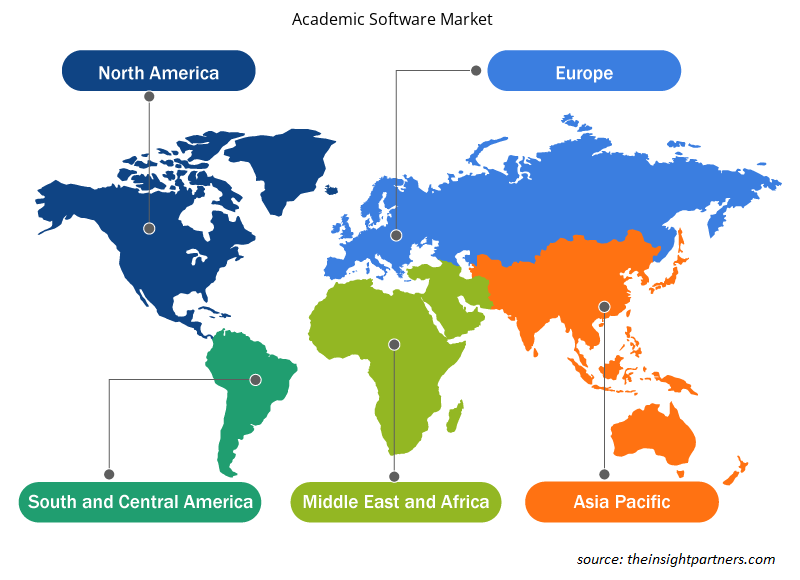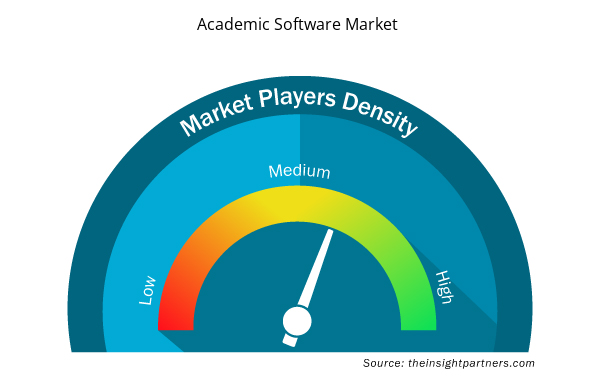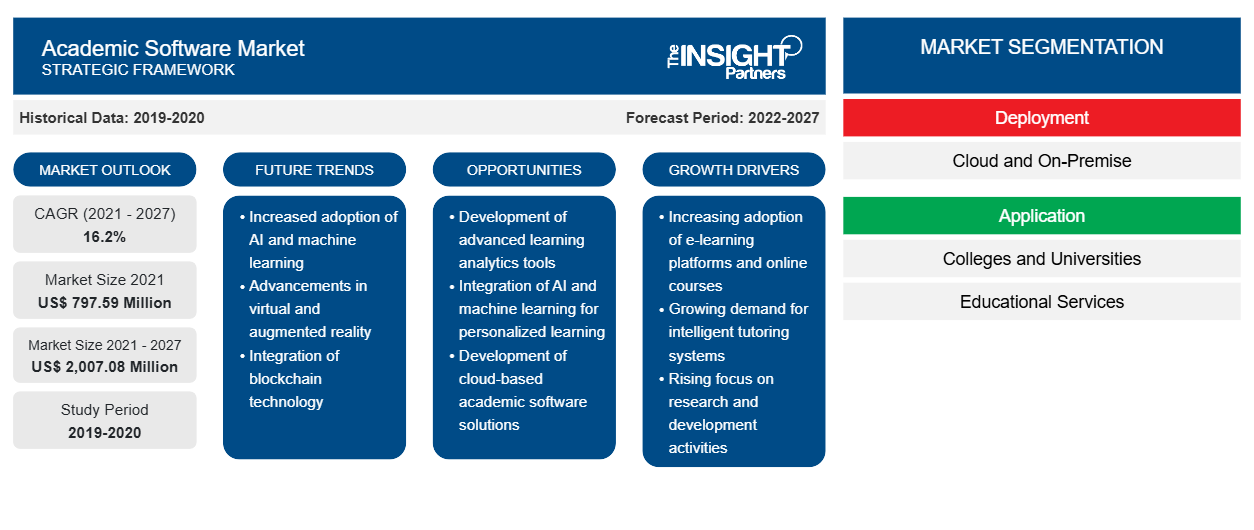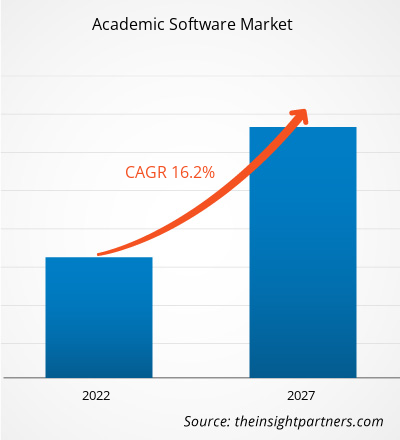学术软件市场预计将从 2021 年的 7.9759 亿美元增长到 2027 年的 20.0708 亿美元。预计在 2021 年至 2027 年的预测期内,学术软件市场将以 16.2% 的复合年增长率增长。
各机构越来越多地采用电子学习是推动学术软件市场增长的关键因素。在电子学习中,通过阅读或观看内容,它正在改变教育的传递方式。动画、播客和视频等多种电子学习课程创造了一种多模式、逼真的学习环境。电子学习、教育内容通过电脑、笔记本电脑、平板电脑或智能手机为学习者提供了多种沉浸式学习机会。学生不必处于被动的环境中,而是可以轻松快速地选择自己需要学习的内容。这些好处正在增加全球对学术软件的需求。
COVID-19 疫情严重影响了全球教育行业。这也推动了全球各主要经济体采用在线教育系统;从而影响了各种应用软件的采用,例如远程授课、管理学生和其他运营活动。因此,预计整个行业对技术先进解决方案的采用将对疫情期间学术软件市场的增长产生积极影响。
根据部署,学术软件市场分为云和本地。2019 年,云部分占据了更高的市场份额。近年来,技术行业稳步见证了云计算的采用大幅增长。这是因为云计算简化了实施时间并大幅降低了部署成本。这一优势吸引了大量最终用户;因此,大多数学术软件市场参与者都提供基于云的产品,以满足对基于云的软件日益增长的需求。此外,发达国家的互联网基础设施已经发展并在许多发展中国家蓬勃发展,使最终用户能够访问发达国家和发展中国家的基于云的解决方案
定制此报告以满足您的需求
您可以免费定制任何报告,包括本报告的部分内容、国家级分析、Excel 数据包,以及为初创企业和大学提供优惠和折扣
- 获取此报告的关键市场趋势。这个免费样品将包括数据分析,从市场趋势到估计和预测。
学术软件市场洞察
人工智能等技术与学术软件解决方案的融合
人工智能 (AI) 是一种技术,它使计算机能够像人类一样与人交流、理解事件、学习并对事件做出反应。多年来,人工智能不仅在各个行业(如安全、监控和信息技术)中得到了广泛的应用,而且在教育领域的应用也日益广泛。学校、学院和大学正在采用人工智能来自动执行重复性任务,如评分、财务分析和录取流程。例如,可以通过先进的计算机程序(如自动评分)对人工智能进行校准,以学习和模拟教师评分时的行为,以便将来自动评分。随着时间的推移,该程序将学习多名学生的学术技能,并根据他们的表现制定定制的培训计划。
基于部署的市场洞察
根据部署类型,全球学术软件市场分为云和本地。与本地学术软件相比,基于云的学术软件需求量很大。由于发达国家拥有强大的网络基础设施,云部分的成本相对较低,因此产生了大部分需求。此外,基于云的学术软件供应商高度专注于开发高级安全补丁,以消除网络攻击的风险。这一因素也产生了来自最终用户的巨大需求,从而推动了学术软件市场的发展。
基于应用的市场洞察
根据应用,学术软件市场分为高校、教育服务和其他。教育机构和大学越来越多地采用现代解决方案,为学生提供在线和离线课程,同时还积极向所有教职员工和学生提供先进的解决方案,这些都影响着学术软件的采用。多年来,这推动了市场的增长。
学术软件市场的参与者专注于市场计划、收购和产品发布等策略,以保持其在学术软件市场的地位。学术软件市场主要参与者的一些发展如下:
2020 年 12 月,Alma 学生信息系统平台引入了平均绩点 (GPA) 功能,该功能已添加到成绩册工具中。基于标准的评分 (SBG) 的根源在于将学生反馈和进度衡量与所教授和评估的特定技能相结合,而不是使用单一分数来涵盖多个主题或标准。
2020 年 7 月,ConexED 更新了其 iOS App 2.2.3,以提供更加用户友好的体验。该应用程序使学生、教职员工和教师能够在移动设备上加入虚拟会议和视频会议。
学术软件市场区域洞察
Insight Partners 的分析师已详细解释了预测期内影响学术软件市场的区域趋势和因素。本节还讨论了北美、欧洲、亚太地区、中东和非洲以及南美和中美洲的学术软件市场细分和地理位置。

- 获取学术软件市场的区域特定数据
学术软件市场报告范围
| 报告属性 | 细节 |
|---|---|
| 2021 年市场规模 | 7.9759亿美元 |
| 2027 年市场规模 | 20.0708亿美元 |
| 全球复合年增长率(2021 - 2027 年) | 16.2% |
| 史料 | 2019-2020 |
| 预测期 | 2022-2027 |
| 涵盖的领域 | 按部署
|
| 覆盖地区和国家 | 北美
|
| 市场领导者和主要公司简介 |
|
学术软件市场参与者密度:了解其对商业动态的影响
学术软件市场正在快速增长,其驱动力是终端用户需求的增加,而这些需求又源于消费者偏好的不断变化、技术进步以及对产品优势的认识不断提高等因素。随着需求的增加,企业正在扩大其产品范围,进行创新以满足消费者需求,并利用新兴趋势,从而进一步推动市场增长。
市场参与者密度是指在特定市场或行业内运营的企业或公司的分布情况。它表明在给定市场空间中,相对于其规模或总市场价值,有多少竞争对手(市场参与者)存在。
在学术软件市场运营的主要公司有:
- 阿尔玛
- 校园咖啡厅软件
- ConexED
- Envisio Solutions Inc.
- 全面料
免责声明:上面列出的公司没有按照任何特定顺序排列。

- 获取学术软件市场顶级关键参与者概览
学术软件市场 – 按部署
- 云
- 本地部署
学术软件市场 – 按应用分类
- 学院和大学
- 教育服务
- 其他的
学术软件市场 – 按地区划分
北美
- 我们
- 加拿大
- 墨西哥
欧洲
- 法国
- 德国
- 俄罗斯
- 英国
- 意大利
- 欧洲其他地区
亚太地区 (APAC)
- 中国
- 印度
- 日本
- 澳大利亚
- 韩国
- 亚太地区其他地区
中东及非洲
- 沙特阿拉伯
- 阿联酋
- 南非
- MEA 其他地区
山姆
- 巴西
- 阿根廷
- SAM 其余部分
学术软件市场 – 公司简介
- 阿尔玛
- 校园咖啡厅软件
- ConexED
- Envisio Solutions Inc.
- 全面料
- PowerVista 软件公司
- Qualtrics 有限责任公司
- Tophatmonocle 公司
- 真对话
- 威兹蜂巢
- 历史分析(2 年)、基准年、预测(7 年)及复合年增长率
- PEST 和 SWOT 分析
- 市场规模价值/数量 - 全球、区域、国家
- 行业和竞争格局
- Excel 数据集



Report Coverage
Revenue forecast, Company Analysis, Industry landscape, Growth factors, and Trends

Segment Covered
This text is related
to segments covered.

Regional Scope
North America, Europe, Asia Pacific, Middle East & Africa, South & Central America

Country Scope
This text is related
to country scope.
常见问题
Increase in adoption of modern technologies and rapid shift from traditional teaching methodologies to modern teaching techniques are influencing the adoption of academic software solutions across colleges and universities across the globe. Additionally, software packages taken by universities and colleges for a large number of users are also cost efficient for both the institutions and the students. In the private sector, for instance, many software packages that a student wants are very expensive. This is why VIVES University of Applied Sciences has developed a partnership to deliver academic solutions with Signpost. Bulk transaction or software license transactions would substantially lower the cost of all their students' required application. A standard software package is compiled by VIVES on Signpost's Academic Software platform, which consists of hundreds of software titles that must be purchased by any VIVES student as a compulsory learning material, regardless of the education or training process. The same can be installed and used on personal laptops and desktops of students. Thus, increasing initiatives by colleges and universities to install bulk academic solutions for students are contributing to the academic software market growth across the globe.
The software industry is growing at a fast pace in the region as it attracts various technological developments. The US federal government spends ~US$ 79 billion every year on the development of primary and secondary education programs. In addition, the trend of privatizing schools in the US is prevailing which is another aspect that would help in boosting the scope of integrating advanced software in schools. In the 21st century, the education sector is experiencing numerous efforts to privatize educational services which were provided by public agencies & school systems. Privatization is expected to transform the method of running schools and will open up opportunities for integrating new software and technologies to manage operations in educational institutes efficiently.
Artificial intelligence (AI) is a technology that gives computers the ability, in the same way as humans, to communicate with people, understand events, and learn and react to events. Over the years, artificial intelligence not only had huge applications across industries—such as security and surveillance and information technology—but it had also experienced a rise in adoption of the technologies in the education sector. AI is being adopted across schools, colleges, and universities for automating repetitive tasks, such as grading, financial analysis, and admission processes. For example, AI can be calibrated to learn and model teacher actions while grading, through advanced computer programs—such as Automated Grading—for automatic grade assignment in the future. Over time, the program would learn the academic skills of multiple students and, based on their performances, prepare customized training plans.
Trends and growth analysis reports related to Technology, Media and Telecommunications : READ MORE..
The List of Companies - Academic Software Market
- Alma
- CAMPUS CAFÉ SOFTWARE
- ConexED
- Envisio Solutions Inc.
- FULL FABRIC
- PowerVista Software, Inc.
- Qualtrics LLC
- Tophatmonocle Corp
- TrueDialog
- WizeHive
The Insight Partners performs research in 4 major stages: Data Collection & Secondary Research, Primary Research, Data Analysis and Data Triangulation & Final Review.
- Data Collection and Secondary Research:
As a market research and consulting firm operating from a decade, we have published and advised several client across the globe. First step for any study will start with an assessment of currently available data and insights from existing reports. Further, historical and current market information is collected from Investor Presentations, Annual Reports, SEC Filings, etc., and other information related to company’s performance and market positioning are gathered from Paid Databases (Factiva, Hoovers, and Reuters) and various other publications available in public domain.
Several associations trade associates, technical forums, institutes, societies and organization are accessed to gain technical as well as market related insights through their publications such as research papers, blogs and press releases related to the studies are referred to get cues about the market. Further, white papers, journals, magazines, and other news articles published in last 3 years are scrutinized and analyzed to understand the current market trends.
- Primary Research:
The primarily interview analysis comprise of data obtained from industry participants interview and answers to survey questions gathered by in-house primary team.
For primary research, interviews are conducted with industry experts/CEOs/Marketing Managers/VPs/Subject Matter Experts from both demand and supply side to get a 360-degree view of the market. The primary team conducts several interviews based on the complexity of the markets to understand the various market trends and dynamics which makes research more credible and precise.
A typical research interview fulfils the following functions:
- Provides first-hand information on the market size, market trends, growth trends, competitive landscape, and outlook
- Validates and strengthens in-house secondary research findings
- Develops the analysis team’s expertise and market understanding
Primary research involves email interactions and telephone interviews for each market, category, segment, and sub-segment across geographies. The participants who typically take part in such a process include, but are not limited to:
- Industry participants: VPs, business development managers, market intelligence managers and national sales managers
- Outside experts: Valuation experts, research analysts and key opinion leaders specializing in the electronics and semiconductor industry.
Below is the breakup of our primary respondents by company, designation, and region:

Once we receive the confirmation from primary research sources or primary respondents, we finalize the base year market estimation and forecast the data as per the macroeconomic and microeconomic factors assessed during data collection.
- Data Analysis:
Once data is validated through both secondary as well as primary respondents, we finalize the market estimations by hypothesis formulation and factor analysis at regional and country level.
- Macro-Economic Factor Analysis:
We analyse macroeconomic indicators such the gross domestic product (GDP), increase in the demand for goods and services across industries, technological advancement, regional economic growth, governmental policies, the influence of COVID-19, PEST analysis, and other aspects. This analysis aids in setting benchmarks for various nations/regions and approximating market splits. Additionally, the general trend of the aforementioned components aid in determining the market's development possibilities.
- Country Level Data:
Various factors that are especially aligned to the country are taken into account to determine the market size for a certain area and country, including the presence of vendors, such as headquarters and offices, the country's GDP, demand patterns, and industry growth. To comprehend the market dynamics for the nation, a number of growth variables, inhibitors, application areas, and current market trends are researched. The aforementioned elements aid in determining the country's overall market's growth potential.
- Company Profile:
The “Table of Contents” is formulated by listing and analyzing more than 25 - 30 companies operating in the market ecosystem across geographies. However, we profile only 10 companies as a standard practice in our syndicate reports. These 10 companies comprise leading, emerging, and regional players. Nonetheless, our analysis is not restricted to the 10 listed companies, we also analyze other companies present in the market to develop a holistic view and understand the prevailing trends. The “Company Profiles” section in the report covers key facts, business description, products & services, financial information, SWOT analysis, and key developments. The financial information presented is extracted from the annual reports and official documents of the publicly listed companies. Upon collecting the information for the sections of respective companies, we verify them via various primary sources and then compile the data in respective company profiles. The company level information helps us in deriving the base number as well as in forecasting the market size.
- Developing Base Number:
Aggregation of sales statistics (2020-2022) and macro-economic factor, and other secondary and primary research insights are utilized to arrive at base number and related market shares for 2022. The data gaps are identified in this step and relevant market data is analyzed, collected from paid primary interviews or databases. On finalizing the base year market size, forecasts are developed on the basis of macro-economic, industry and market growth factors and company level analysis.
- Data Triangulation and Final Review:
The market findings and base year market size calculations are validated from supply as well as demand side. Demand side validations are based on macro-economic factor analysis and benchmarks for respective regions and countries. In case of supply side validations, revenues of major companies are estimated (in case not available) based on industry benchmark, approximate number of employees, product portfolio, and primary interviews revenues are gathered. Further revenue from target product/service segment is assessed to avoid overshooting of market statistics. In case of heavy deviations between supply and demand side values, all thes steps are repeated to achieve synchronization.
We follow an iterative model, wherein we share our research findings with Subject Matter Experts (SME’s) and Key Opinion Leaders (KOLs) until consensus view of the market is not formulated – this model negates any drastic deviation in the opinions of experts. Only validated and universally acceptable research findings are quoted in our reports.
We have important check points that we use to validate our research findings – which we call – data triangulation, where we validate the information, we generate from secondary sources with primary interviews and then we re-validate with our internal data bases and Subject matter experts. This comprehensive model enables us to deliver high quality, reliable data in shortest possible time.


 获取此报告的免费样本
获取此报告的免费样本